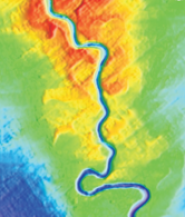Research Focus Coastal and Sedimentary Systems
Faculty of Geosciences, MARUM and Associated Members

Coastal and sedimentary systems are in steady transformation: tides, winds, rivers, waves and large-scale ocean currents leave their traces in sedimentary structures and form ever-changing patterns in sizes from a few centimeters to many kilometers. Among these features are ripple fields, barrier islands, mud belts and drift bodies. At the continental slopes, gravitational transport prevails creating submarine canyons and landslides. The sediments of the deep sea vary mainly according to formation, dissolution or preservation of their biogenic components. How did these sedimentary systems evolve and what is their role as living space for marine organisms? Which are the consequences of coastal protection, trawling and seafloor mining? How do fossil and modern coastal and sedimentary systems compare? The proximity to our German coasts, the marine technology and the numerous research cooperations of MARUM offer prime conditions to study sedimentary processes "in depth".
Research Programs and Structures
- MARUM - Center for Marine Environmental Sciences
Research Area "Seafloor Dynamics" - GLOMAR Research Theme "Ocean & Seafloor"
Offers to support professional and personal development at MARUM
Research Groups and their Core Areas
- FB5 Research Group Geotechnics Prof. Dr. Achim Kopf
Slope Stability, Pore Pressure, Mud Volcanism, Geotechnical lab and in situ Measurements - FB5 Research Group MiÂcroÂpaÂlaeÂonÂtoÂlogy-PaÂlaeoceanÂoÂgraphy Prof. Dr. Michal Kucera
Micropaleontology, Biology of Foraminifera, Marine Palynology, Paleoceanography - FB5 Research Group Marine Technology â Environmental Research Prof. Dr. Volkhard SpieÃ
Subbottom Profiling, High-Resolution Multichannel Seismics, Swath Bathymetry - FB5 Research Group Modelling of Sedimentation Processes Prof. Dr. Katrin Huhn-Frehers
Numerical Modelling, Sediment Transport, Time Series Analysis - FB5 Research Group Sedimentology Prof. Dr. Elda Miramontes GarcÃa
Deep marine sediments, dunes, coccolithophores - MARUM Working Group Marine Sedimentology Prof. Dr. Dierk Hebbeln
Palaeoceanography and Climate, Cold-Water Corals, Sediment Dynamics - SaM Dptm. Marine Sedimentology Dr. Alexander BartolomÃĪ
Sediment Transport and Accumulation in marine and estuarine environments




